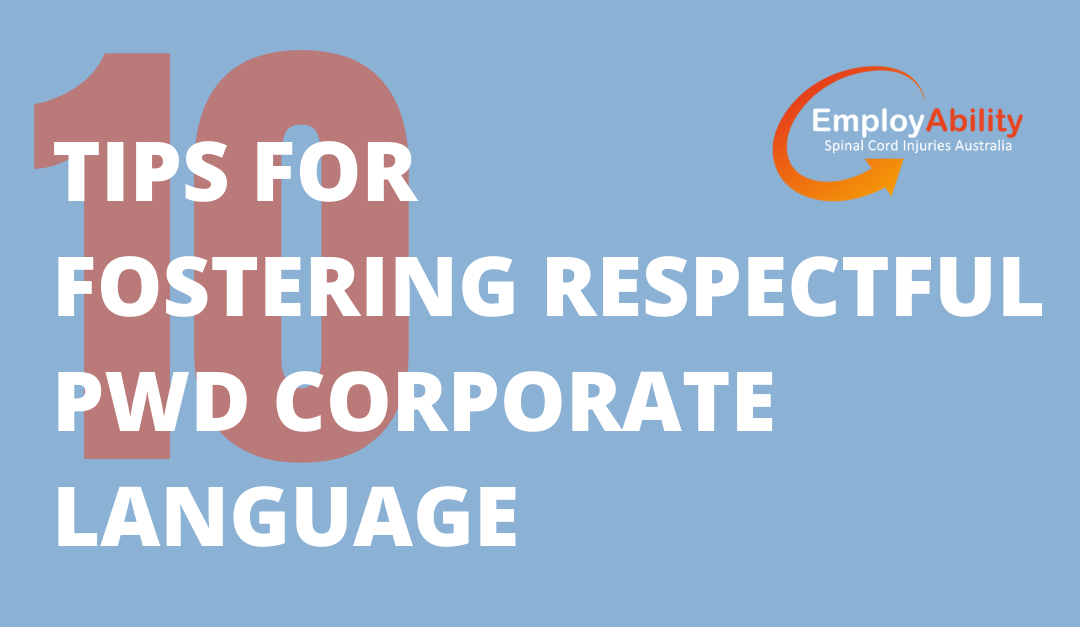Last month we shared a wonderful video from PWDA on Disability Language to help with those tearoom conversations.
Why? Because just as it is in the school yard, on the bus or on the street, in a corporate setting, language plays a crucial role in fostering an inclusive, respectful, and professional environment.
Here are some key rules and guidelines to consider:
Use Inclusive Language
- Avoid Bias: Use language that is free of stereotypes, prejudice, or assumptions about any group, including gender, race, ethnicity, age, religion, sexual orientation, disability, and socioeconomic status. For example, use “chairperson” instead of “chairman” and “humankind” instead of “mankind.”
- Person-First Language: When referring to people with disabilities, use person-first language unless the individual or community prefers identity-first language. For example, say “a person with a disability” rather than “a disabled person.”
- Gender-Neutral Terms: Use terms that do not assume a person’s gender, such as “they/them” pronouns for unspecified gender or job titles like “salesperson” instead of “salesman.”
Be Professional and Respectful
- Avoid Informal or Slang Language: In professional settings, avoid slang, colloquialisms, or jargon that might be unclear or offensive to others.
- Politeness and Courtesy: Always use polite and respectful language in communications, including emails, meetings, and casual conversations. Phrases like “please,” “thank you,” and “excuse me” should be standard practice.
- Avoid Negative or Discriminatory Language: Do not use language that could be interpreted as discriminatory, derogatory, or offensive towards any individual or group. This includes avoiding terms that carry negative connotations or historical prejudice.
Practice Cultural Sensitivity
- Respect Cultural Differences: Be mindful of cultural differences in language use and communication styles. What is acceptable in one culture may be inappropriate in another.
- Avoid Cultural Appropriation: Do not use phrases, words, or expressions that are derived from cultures inappropriately or without understanding their significance.
Maintain Clarity and Precision
- Clear and Concise Language: Use clear and concise language to avoid misunderstandings. Be specific in your communication and avoid ambiguity.
- Professional Tone: Maintain a professional tone in all communications, avoiding overly casual or informal language unless it suits the context and relationship.
Be Mindful of Context
- Adjust Language Based on Audience: Adapt your language to suit the audience, context, and situation. Formal language may be more appropriate in meetings or written communications, while more relaxed language may be acceptable in informal settings.
- Sensitive Topics: When discussing sensitive topics, such as race, religion, disability, or gender, choose your words carefully to ensure they are respectful and appropriate.
Encourage Open Communication
- Promote Feedback and Dialogue: Encourage employees to provide feedback on language use and create an open environment where people feel comfortable discussing any concerns about language.
- Acknowledge Mistakes: If you use inappropriate language or make a mistake, acknowledge it, apologise, and learn from the experience.
Avoid Assumptions
- Do Not Assume Identities: Avoid making assumptions about a person’s identity, including their gender, sexual orientation, or background. If unsure, it’s better to ask respectfully rather than assume.
Use Appropriate Language for Disability
- Respect Preferences: When referring to people with disabilities, use the language that they prefer. This can be person-first language (e.g., “a person with a disability”) or identity-first language (e.g., “a Deaf person”) depending on the individual’s preference.
Avoid Jargon and Acronyms
- Use Plain Language: Avoid using technical jargon, acronyms, or industry-specific language that may not be understood by everyone, especially in cross-departmental or public communications.
Adopt an Anti-Harassment and Non-Discriminatory Language Policy
- Formal Policies: Organisations should have clear policies that prohibit the use of offensive, discriminatory, or harassing language in the workplace.
- Training and Awareness: Provide regular training and awareness sessions on the use of inclusive and respectful language.
By following these guidelines, organisations can create a more inclusive and respectful workplace, fostering better communication and collaboration among all employees. If you would like to learn more, please contact us

